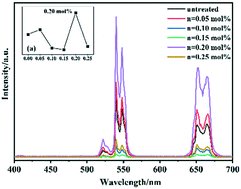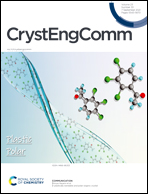Enhanced up-conversion emission in Er3+-doped barium–natrium–yttrium–fluoride phosphors by alkali ion introduction under 1550 nm excitation†
Abstract
In this work, multi-component fluoride phosphors BaxNay−nMnYzF2x+y+3z+3m : Er3+m (M = Li and K) sensitive to 1550 nm were synthesized by the low-temperature combustion synthesis (LCS) method. The optimum batch formula was determined by orthogonal experiments. The effects of introducing alkali ions (Li+, K+) on phase formation and luminescence intensity were systematically studied. The results indicate that the luminescence intensity of 0.2 mol% Li+-introduced nanoparticles is obviously enhanced, and the diffraction peak is shifted to the direction of a smaller diffraction angle, which is attributed to the lattice expansion caused by Li+ ions entering the lattice gap that changes the local symmetry of Er3+ ions. The phase composition and morphology of phosphors were analyzed by X-ray diffraction and scanning electron microscopy (SEM). The product exhibited Er3+ ion characteristic emission under 1550 nm excitation, and its luminescence mechanism was studied. This work provides a new idea for improving the luminescence intensity of up-conversion luminescent materials (UCL) under 1.5 μm excitation.

- This article is part of the themed collection: Crystal Engineering Techniques


 Please wait while we load your content...
Please wait while we load your content...